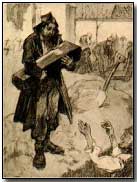Encyclopedia - Franc-Tireur
 Translated from the French
as literally "free shooter" and originating from the 1870-71 Franco-Prussian
War, 'franc-tireur' was the term used to describe civilians who took up arms
against an enemy power contrary to the usual rules of war.
Translated from the French
as literally "free shooter" and originating from the 1870-71 Franco-Prussian
War, 'franc-tireur' was the term used to describe civilians who took up arms
against an enemy power contrary to the usual rules of war.
During the First World War the term was most commonly attributed to Belgian citizenry who took to sniping in opposition to the neutral country's occupying German force.
As the number of German deaths attributable to such sharp-shooters steadily increased in Belgium during August 1914 so the German high command took to implementing harsh retaliatory punishment tactics. Entire villages were held responsible for German casualties at the hands of Belgian snipers
Villages were occasionally razed to the ground to discourage such activity. Atrocities (such as at Dinant and Louvain in August 1914) were widely reported throughout the world and led to the occupying German forces being labelled 'Huns'.
Outraged by German tactics in Belgium the Dutch artist and cartoonist Louis Raemaekers began publishing the first in what eventually totalled some 1,000 cartoons depicting the Germans as the enemy of civilisation (for which the German government unsuccessfully placed a bounty of 12,000 Guilders on his head, dead or alive).
Nevertheless the German Army's tactics in discouraging franc-tireurs succeeded only in alienating potential German support in key neutral countries, including the United States.
An Armlet was a cloth band worn around the arm to identify a particular duty or function.
- Did you know?
